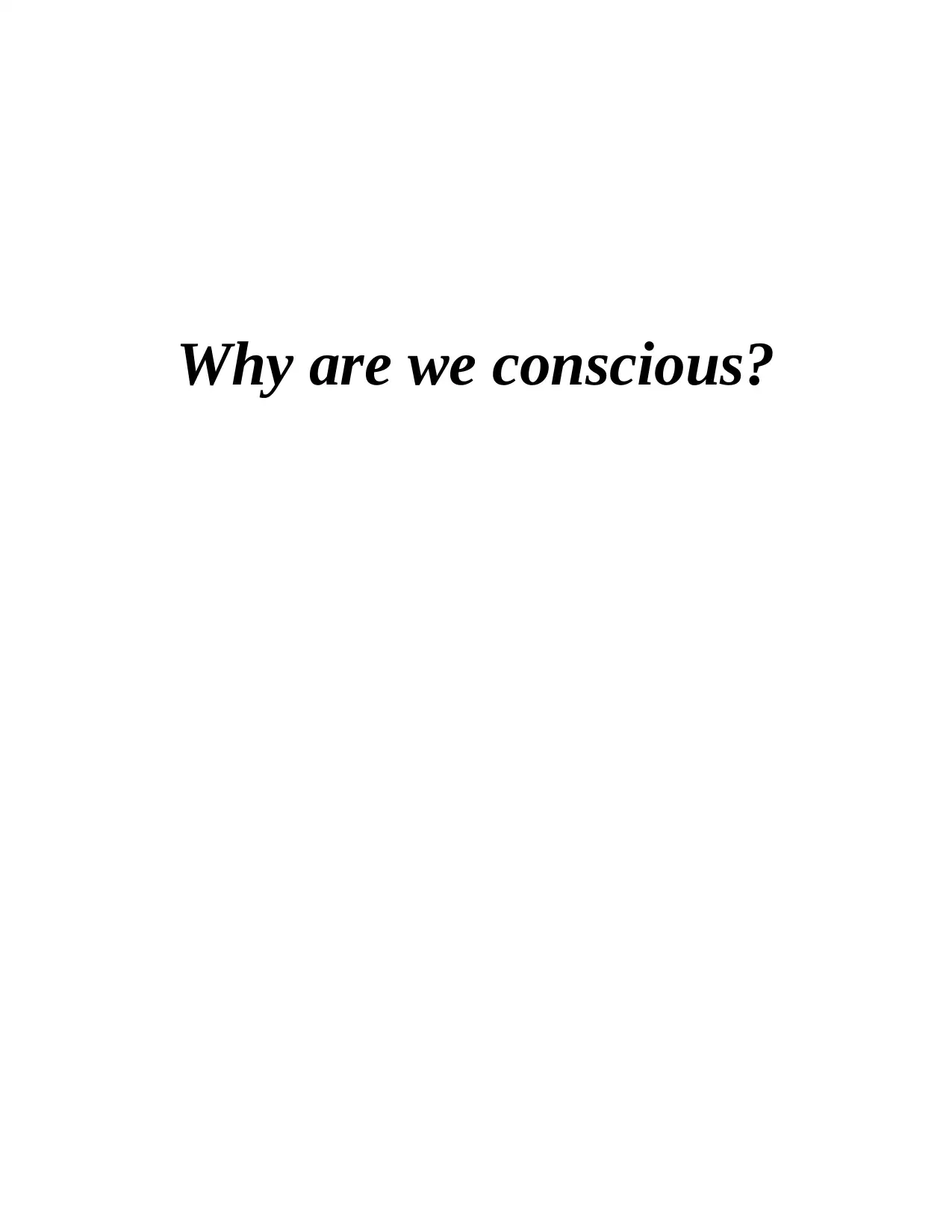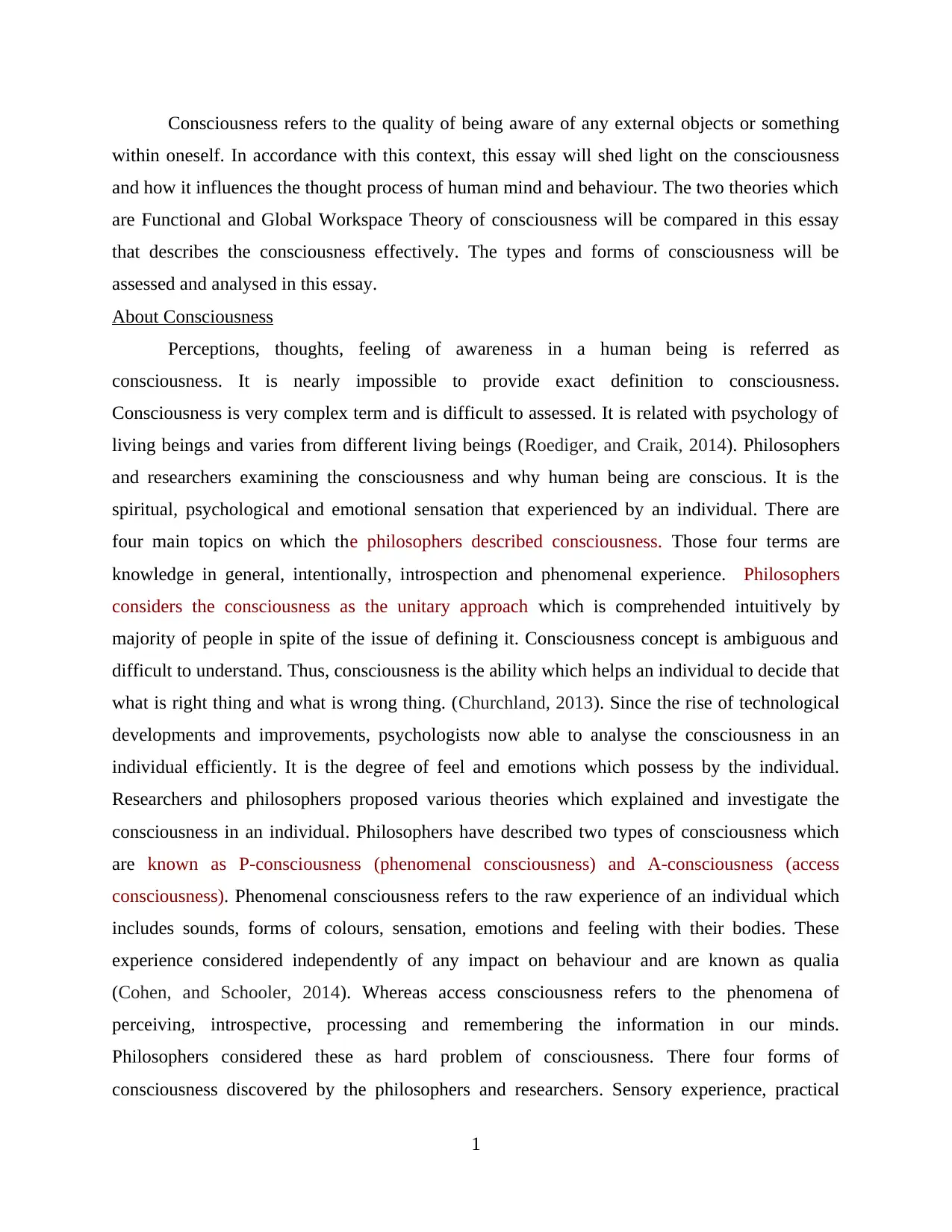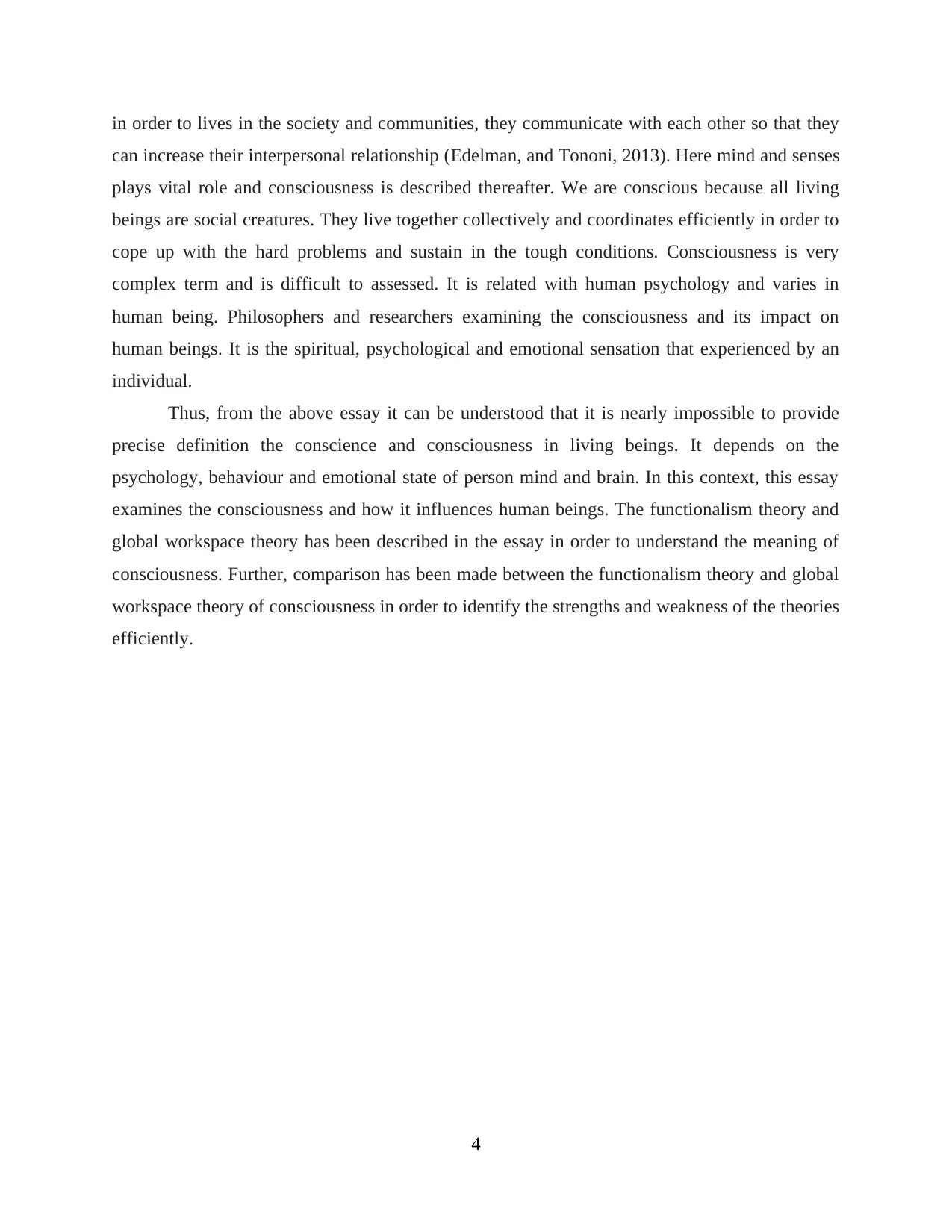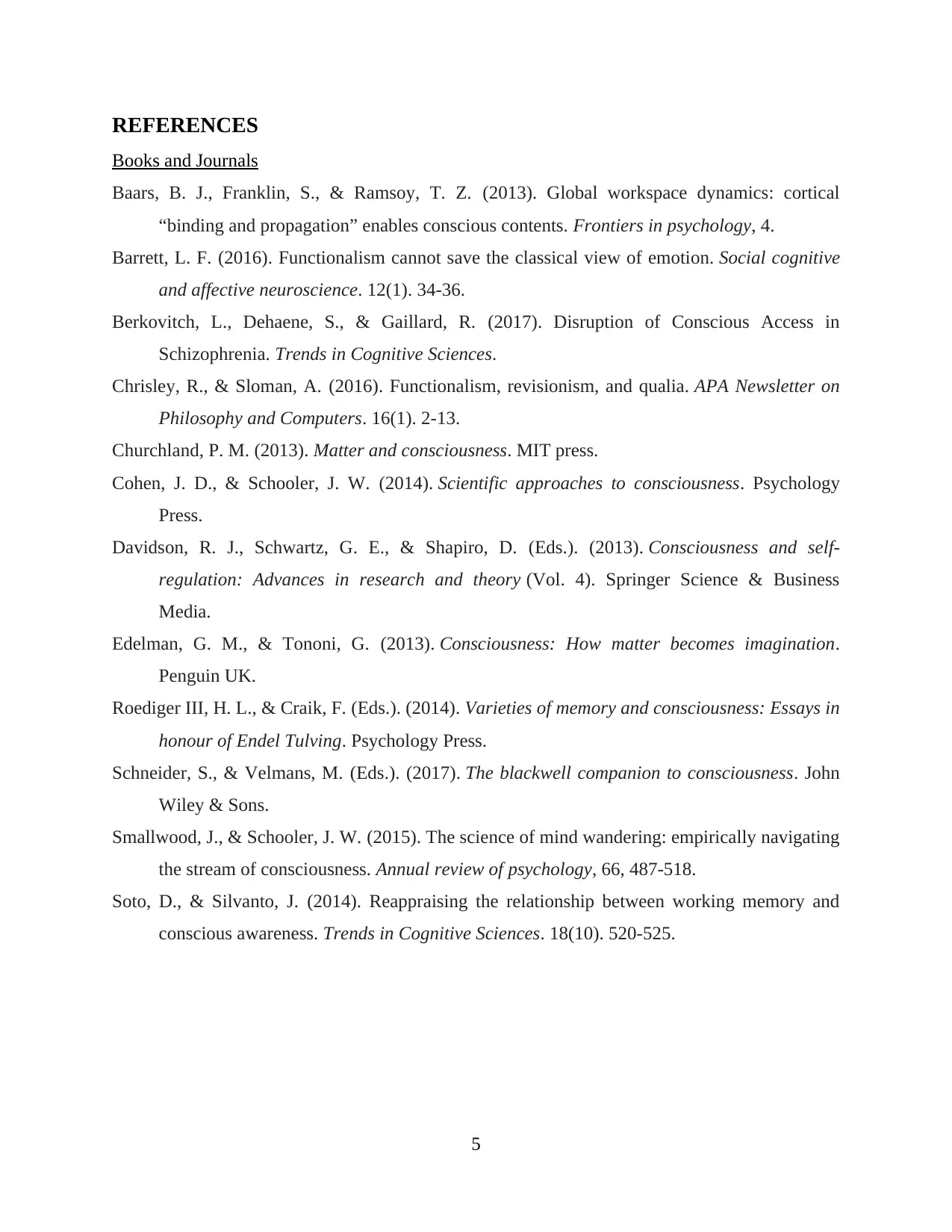A Comparative Analysis of Consciousness Theories and Forms Essay
VerifiedAdded on 2020/06/05
|6
|1994
|229
Essay
AI Summary
This essay delves into the multifaceted concept of consciousness, exploring its influence on the human thought process and behavior. It begins by defining consciousness and acknowledging its complexity, then proceeds to compare and contrast two prominent theories: Functionalism and Global Workspace Theory. The essay examines the different types and forms of consciousness, providing a comprehensive overview of sensory, practical, reflective, and reflexive consciousness. It also discusses the philosophical aspects of consciousness, including P-consciousness and A-consciousness. The analysis extends to how consciousness impacts social interactions and interpersonal relationships. The essay concludes by highlighting the strengths and weaknesses of each theory, offering insights into understanding the human mind and behavior. References from various books and journals are also included.

Why are we conscious?
Paraphrase This Document
Need a fresh take? Get an instant paraphrase of this document with our AI Paraphraser

Consciousness refers to the quality of being aware of any external objects or something
within oneself. In accordance with this context, this essay will shed light on the consciousness
and how it influences the thought process of human mind and behaviour. The two theories which
are Functional and Global Workspace Theory of consciousness will be compared in this essay
that describes the consciousness effectively. The types and forms of consciousness will be
assessed and analysed in this essay.
About Consciousness
Perceptions, thoughts, feeling of awareness in a human being is referred as
consciousness. It is nearly impossible to provide exact definition to consciousness.
Consciousness is very complex term and is difficult to assessed. It is related with psychology of
living beings and varies from different living beings (Roediger, and Craik, 2014). Philosophers
and researchers examining the consciousness and why human being are conscious. It is the
spiritual, psychological and emotional sensation that experienced by an individual. There are
four main topics on which the philosophers described consciousness. Those four terms are
knowledge in general, intentionally, introspection and phenomenal experience. Philosophers
considers the consciousness as the unitary approach which is comprehended intuitively by
majority of people in spite of the issue of defining it. Consciousness concept is ambiguous and
difficult to understand. Thus, consciousness is the ability which helps an individual to decide that
what is right thing and what is wrong thing. (Churchland, 2013). Since the rise of technological
developments and improvements, psychologists now able to analyse the consciousness in an
individual efficiently. It is the degree of feel and emotions which possess by the individual.
Researchers and philosophers proposed various theories which explained and investigate the
consciousness in an individual. Philosophers have described two types of consciousness which
are known as P-consciousness (phenomenal consciousness) and A-consciousness (access
consciousness). Phenomenal consciousness refers to the raw experience of an individual which
includes sounds, forms of colours, sensation, emotions and feeling with their bodies. These
experience considered independently of any impact on behaviour and are known as qualia
(Cohen, and Schooler, 2014). Whereas access consciousness refers to the phenomena of
perceiving, introspective, processing and remembering the information in our minds.
Philosophers considered these as hard problem of consciousness. There four forms of
consciousness discovered by the philosophers and researchers. Sensory experience, practical
1
within oneself. In accordance with this context, this essay will shed light on the consciousness
and how it influences the thought process of human mind and behaviour. The two theories which
are Functional and Global Workspace Theory of consciousness will be compared in this essay
that describes the consciousness effectively. The types and forms of consciousness will be
assessed and analysed in this essay.
About Consciousness
Perceptions, thoughts, feeling of awareness in a human being is referred as
consciousness. It is nearly impossible to provide exact definition to consciousness.
Consciousness is very complex term and is difficult to assessed. It is related with psychology of
living beings and varies from different living beings (Roediger, and Craik, 2014). Philosophers
and researchers examining the consciousness and why human being are conscious. It is the
spiritual, psychological and emotional sensation that experienced by an individual. There are
four main topics on which the philosophers described consciousness. Those four terms are
knowledge in general, intentionally, introspection and phenomenal experience. Philosophers
considers the consciousness as the unitary approach which is comprehended intuitively by
majority of people in spite of the issue of defining it. Consciousness concept is ambiguous and
difficult to understand. Thus, consciousness is the ability which helps an individual to decide that
what is right thing and what is wrong thing. (Churchland, 2013). Since the rise of technological
developments and improvements, psychologists now able to analyse the consciousness in an
individual efficiently. It is the degree of feel and emotions which possess by the individual.
Researchers and philosophers proposed various theories which explained and investigate the
consciousness in an individual. Philosophers have described two types of consciousness which
are known as P-consciousness (phenomenal consciousness) and A-consciousness (access
consciousness). Phenomenal consciousness refers to the raw experience of an individual which
includes sounds, forms of colours, sensation, emotions and feeling with their bodies. These
experience considered independently of any impact on behaviour and are known as qualia
(Cohen, and Schooler, 2014). Whereas access consciousness refers to the phenomena of
perceiving, introspective, processing and remembering the information in our minds.
Philosophers considered these as hard problem of consciousness. There four forms of
consciousness discovered by the philosophers and researchers. Sensory experience, practical
1

consciousness, reflective consciousness and reflexive consciousness are the four forms of
consciousness. (Davidson,, Schwartz and Shapiro, 2013). The phenomenal sense that something
exists in relation to or has an impact on a person is known as sensory consciousness. Practical
consciousness refers knowing how to do things and knowing how to move on. It is also known as
basic to human engagement. Reflective consciousness refers to the modality in which an
individual reflect upon the fist two form. It is the day to day thinking of human beings in which
they decide what to do and what is to be done.
An individual experience reflexive consciousness where he or she reflects on the basis of
reflection and inspecting the nature of knowing in the context of constitutive conditions of living
being. Human beings are social creatures who lives and adapts the culture of the surroundings. In
order to increases the interpersonal relationships with other human beings, an individual always
makes communication first by considering the fact that another person is conscious (Smallwood
and Schooler, 2015). In order to adjust in the environment appropriate coordination is required.
Thus, in order to predict what someone else might do based upon what an individual think. In
this context, an individual assumes the other person is conscious and that is why he or she is also
conscious. In order to increase the interaction in the community it is important for a human being
to be consciousness.
Functional and Global Workspace Theory of Consciousness
Functionalism is a view in the theory of the mind. It refers to the mental and
psychological state of mind which includes beliefs, desires, being in pain, etc. An essential part
of some accounts, functionalism is the idea of multiple realisability (Chrisley and Sloman, 2016).
It refers to the psychological state and the thought process of an individual which takes place in
his or her mind or brain. The Functional Specification Theory developed by David Lewis and
David Malet Armstrong states that mental states are particular realisers of the functional role.
Functional Specification Theory do not allow for the multiple collection of theory of
mental states, because it considered the brain mental state is vital and essential. Integrated
information theory is the other version of functionalism theory. The integrated information
theory states that the level of consciousness of a system at a time is a matter of how many
possible states it has at that time and how tightly integrated its states are (Barrett, 2016). Bernard
Baars developed the Global Workforce Theory which states that there is neutral network
approach where competition exists between coalitions and neural which includes both sensory
2
consciousness. (Davidson,, Schwartz and Shapiro, 2013). The phenomenal sense that something
exists in relation to or has an impact on a person is known as sensory consciousness. Practical
consciousness refers knowing how to do things and knowing how to move on. It is also known as
basic to human engagement. Reflective consciousness refers to the modality in which an
individual reflect upon the fist two form. It is the day to day thinking of human beings in which
they decide what to do and what is to be done.
An individual experience reflexive consciousness where he or she reflects on the basis of
reflection and inspecting the nature of knowing in the context of constitutive conditions of living
being. Human beings are social creatures who lives and adapts the culture of the surroundings. In
order to increases the interpersonal relationships with other human beings, an individual always
makes communication first by considering the fact that another person is conscious (Smallwood
and Schooler, 2015). In order to adjust in the environment appropriate coordination is required.
Thus, in order to predict what someone else might do based upon what an individual think. In
this context, an individual assumes the other person is conscious and that is why he or she is also
conscious. In order to increase the interaction in the community it is important for a human being
to be consciousness.
Functional and Global Workspace Theory of Consciousness
Functionalism is a view in the theory of the mind. It refers to the mental and
psychological state of mind which includes beliefs, desires, being in pain, etc. An essential part
of some accounts, functionalism is the idea of multiple realisability (Chrisley and Sloman, 2016).
It refers to the psychological state and the thought process of an individual which takes place in
his or her mind or brain. The Functional Specification Theory developed by David Lewis and
David Malet Armstrong states that mental states are particular realisers of the functional role.
Functional Specification Theory do not allow for the multiple collection of theory of
mental states, because it considered the brain mental state is vital and essential. Integrated
information theory is the other version of functionalism theory. The integrated information
theory states that the level of consciousness of a system at a time is a matter of how many
possible states it has at that time and how tightly integrated its states are (Barrett, 2016). Bernard
Baars developed the Global Workforce Theory which states that there is neutral network
approach where competition exists between coalitions and neural which includes both sensory
2
⊘ This is a preview!⊘
Do you want full access?
Subscribe today to unlock all pages.

Trusted by 1+ million students worldwide

and frontal areas. (Baars, Franklin and Ramsoy, 2013). It refers to the amount of information
available in the brain of human beings. There are various models have been proposed which are
related with the global workspace theory. Electromagnetic field (EMF) is one of them.
According to the first theme which is brain is considered as disturbed society of
specialist, the brain of an individual has many specialist areas which are experts in storing and
analysing of the information efficiently. Baars precisely proposed that there are events going in
the mind which are processing the information effectively (Berkovitch, Dehaene and Gaillard,
2017). These informations processing events which are hypothetical computational processes,
identical to the events of symbol manipulation. The application of computational process is the
neural machine grossly refers to a casual and mechanical process in which language and other
representational vehicles are recognised and transformed. According to the second theme which
is the most essential theme of the theory which the society of all specialised computational
process in the brain is installed with a different memory. The nature of memory is fleeting and
have only one content which is consistent in the time.
Comparison and Contrasting Functional and Global Workspace Theory of Consciousness
The functionalism and global workspace theories of Consciousness is different from each
other respectively. The functional theory describes the mental and psychological state of the
brain of living beings and global workspace theory describes the memory capacity and the
process of transmission of information by brain of living beings. The functional theory describes
the process of consciousness by using limited approaches and models whereas the global
workspace theory of consciousness describes the consciousness in living being by using various
of models and approaches (Soto and Silvanto, 2014). Further, the functional theory focuses on
the metaphysical versions which includes semantic, explanatory and theoretical versions whereas
global workspace theory focuses on the memory of living beings. Consciousness is very difficult
to understand and it we are conscious in order to interact with societies. Functionalism claims
that the nature of mental states is determined by what they do, by how they function (Schneider
and Velmans, 2017). Whereas global workspace theory produces explicit anticipation for
conscious concepts related with vision, motivation, working memory, emotions, learning , self
system and voluntary control of brain.
These theories provide framework so that the process of mind and behaviours of living
beings can be understand and comprehend effectively. As human beings are social creatures and
3
available in the brain of human beings. There are various models have been proposed which are
related with the global workspace theory. Electromagnetic field (EMF) is one of them.
According to the first theme which is brain is considered as disturbed society of
specialist, the brain of an individual has many specialist areas which are experts in storing and
analysing of the information efficiently. Baars precisely proposed that there are events going in
the mind which are processing the information effectively (Berkovitch, Dehaene and Gaillard,
2017). These informations processing events which are hypothetical computational processes,
identical to the events of symbol manipulation. The application of computational process is the
neural machine grossly refers to a casual and mechanical process in which language and other
representational vehicles are recognised and transformed. According to the second theme which
is the most essential theme of the theory which the society of all specialised computational
process in the brain is installed with a different memory. The nature of memory is fleeting and
have only one content which is consistent in the time.
Comparison and Contrasting Functional and Global Workspace Theory of Consciousness
The functionalism and global workspace theories of Consciousness is different from each
other respectively. The functional theory describes the mental and psychological state of the
brain of living beings and global workspace theory describes the memory capacity and the
process of transmission of information by brain of living beings. The functional theory describes
the process of consciousness by using limited approaches and models whereas the global
workspace theory of consciousness describes the consciousness in living being by using various
of models and approaches (Soto and Silvanto, 2014). Further, the functional theory focuses on
the metaphysical versions which includes semantic, explanatory and theoretical versions whereas
global workspace theory focuses on the memory of living beings. Consciousness is very difficult
to understand and it we are conscious in order to interact with societies. Functionalism claims
that the nature of mental states is determined by what they do, by how they function (Schneider
and Velmans, 2017). Whereas global workspace theory produces explicit anticipation for
conscious concepts related with vision, motivation, working memory, emotions, learning , self
system and voluntary control of brain.
These theories provide framework so that the process of mind and behaviours of living
beings can be understand and comprehend effectively. As human beings are social creatures and
3
Paraphrase This Document
Need a fresh take? Get an instant paraphrase of this document with our AI Paraphraser

in order to lives in the society and communities, they communicate with each other so that they
can increase their interpersonal relationship (Edelman, and Tononi, 2013). Here mind and senses
plays vital role and consciousness is described thereafter. We are conscious because all living
beings are social creatures. They live together collectively and coordinates efficiently in order to
cope up with the hard problems and sustain in the tough conditions. Consciousness is very
complex term and is difficult to assessed. It is related with human psychology and varies in
human being. Philosophers and researchers examining the consciousness and its impact on
human beings. It is the spiritual, psychological and emotional sensation that experienced by an
individual.
Thus, from the above essay it can be understood that it is nearly impossible to provide
precise definition the conscience and consciousness in living beings. It depends on the
psychology, behaviour and emotional state of person mind and brain. In this context, this essay
examines the consciousness and how it influences human beings. The functionalism theory and
global workspace theory has been described in the essay in order to understand the meaning of
consciousness. Further, comparison has been made between the functionalism theory and global
workspace theory of consciousness in order to identify the strengths and weakness of the theories
efficiently.
4
can increase their interpersonal relationship (Edelman, and Tononi, 2013). Here mind and senses
plays vital role and consciousness is described thereafter. We are conscious because all living
beings are social creatures. They live together collectively and coordinates efficiently in order to
cope up with the hard problems and sustain in the tough conditions. Consciousness is very
complex term and is difficult to assessed. It is related with human psychology and varies in
human being. Philosophers and researchers examining the consciousness and its impact on
human beings. It is the spiritual, psychological and emotional sensation that experienced by an
individual.
Thus, from the above essay it can be understood that it is nearly impossible to provide
precise definition the conscience and consciousness in living beings. It depends on the
psychology, behaviour and emotional state of person mind and brain. In this context, this essay
examines the consciousness and how it influences human beings. The functionalism theory and
global workspace theory has been described in the essay in order to understand the meaning of
consciousness. Further, comparison has been made between the functionalism theory and global
workspace theory of consciousness in order to identify the strengths and weakness of the theories
efficiently.
4

REFERENCES
Books and Journals
Baars, B. J., Franklin, S., & Ramsoy, T. Z. (2013). Global workspace dynamics: cortical
“binding and propagation” enables conscious contents. Frontiers in psychology, 4.
Barrett, L. F. (2016). Functionalism cannot save the classical view of emotion. Social cognitive
and affective neuroscience. 12(1). 34-36.
Berkovitch, L., Dehaene, S., & Gaillard, R. (2017). Disruption of Conscious Access in
Schizophrenia. Trends in Cognitive Sciences.
Chrisley, R., & Sloman, A. (2016). Functionalism, revisionism, and qualia. APA Newsletter on
Philosophy and Computers. 16(1). 2-13.
Churchland, P. M. (2013). Matter and consciousness. MIT press.
Cohen, J. D., & Schooler, J. W. (2014). Scientific approaches to consciousness. Psychology
Press.
Davidson, R. J., Schwartz, G. E., & Shapiro, D. (Eds.). (2013). Consciousness and self-
regulation: Advances in research and theory (Vol. 4). Springer Science & Business
Media.
Edelman, G. M., & Tononi, G. (2013). Consciousness: How matter becomes imagination.
Penguin UK.
Roediger III, H. L., & Craik, F. (Eds.). (2014). Varieties of memory and consciousness: Essays in
honour of Endel Tulving. Psychology Press.
Schneider, S., & Velmans, M. (Eds.). (2017). The blackwell companion to consciousness. John
Wiley & Sons.
Smallwood, J., & Schooler, J. W. (2015). The science of mind wandering: empirically navigating
the stream of consciousness. Annual review of psychology, 66, 487-518.
Soto, D., & Silvanto, J. (2014). Reappraising the relationship between working memory and
conscious awareness. Trends in Cognitive Sciences. 18(10). 520-525.
5
Books and Journals
Baars, B. J., Franklin, S., & Ramsoy, T. Z. (2013). Global workspace dynamics: cortical
“binding and propagation” enables conscious contents. Frontiers in psychology, 4.
Barrett, L. F. (2016). Functionalism cannot save the classical view of emotion. Social cognitive
and affective neuroscience. 12(1). 34-36.
Berkovitch, L., Dehaene, S., & Gaillard, R. (2017). Disruption of Conscious Access in
Schizophrenia. Trends in Cognitive Sciences.
Chrisley, R., & Sloman, A. (2016). Functionalism, revisionism, and qualia. APA Newsletter on
Philosophy and Computers. 16(1). 2-13.
Churchland, P. M. (2013). Matter and consciousness. MIT press.
Cohen, J. D., & Schooler, J. W. (2014). Scientific approaches to consciousness. Psychology
Press.
Davidson, R. J., Schwartz, G. E., & Shapiro, D. (Eds.). (2013). Consciousness and self-
regulation: Advances in research and theory (Vol. 4). Springer Science & Business
Media.
Edelman, G. M., & Tononi, G. (2013). Consciousness: How matter becomes imagination.
Penguin UK.
Roediger III, H. L., & Craik, F. (Eds.). (2014). Varieties of memory and consciousness: Essays in
honour of Endel Tulving. Psychology Press.
Schneider, S., & Velmans, M. (Eds.). (2017). The blackwell companion to consciousness. John
Wiley & Sons.
Smallwood, J., & Schooler, J. W. (2015). The science of mind wandering: empirically navigating
the stream of consciousness. Annual review of psychology, 66, 487-518.
Soto, D., & Silvanto, J. (2014). Reappraising the relationship between working memory and
conscious awareness. Trends in Cognitive Sciences. 18(10). 520-525.
5
⊘ This is a preview!⊘
Do you want full access?
Subscribe today to unlock all pages.

Trusted by 1+ million students worldwide
1 out of 6
Related Documents
Your All-in-One AI-Powered Toolkit for Academic Success.
+13062052269
info@desklib.com
Available 24*7 on WhatsApp / Email
![[object Object]](/_next/static/media/star-bottom.7253800d.svg)
Unlock your academic potential
Copyright © 2020–2025 A2Z Services. All Rights Reserved. Developed and managed by ZUCOL.





